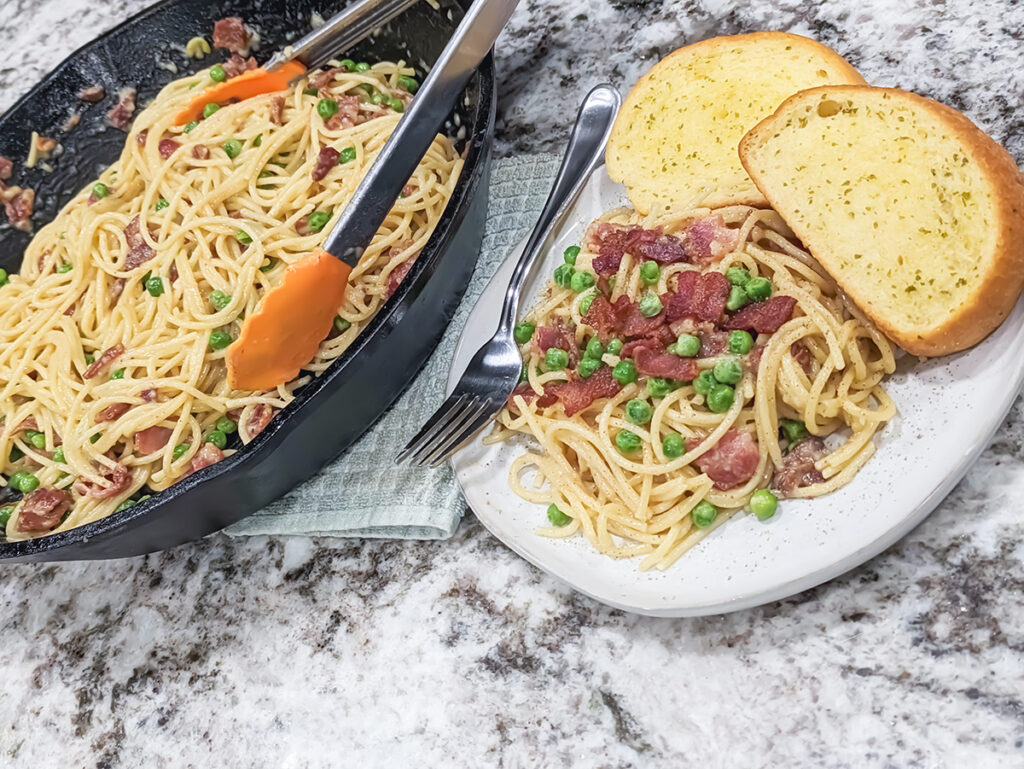As spring gets into full swing, so do activities. We need a recipe that is quick, easy, filling — and bonus points if the kids think it tastes good.
Carbonara is a classic Italian dish that brings the warm, gooey comfort of bacon, eggs and cheese to spaghetti. The name carbonara possibly refers to how the black pepper that covers the finished pasta looks similar to the black flecks of carbon that would cover charcoal heaters used in Italy. Carbonara, despite the elemental origins of its etymology, is a name that is hardly ever spoken in my house, but a dish we eat on an almost weekly basis.
I saw a traditional preparation on a cooking show and figured that I could easily trade out some of the more esoteric components (pancetta, mostly) for stuff we already had in the fridge and pantry. Thus, carbonara was transmogrified to bacon, noodles and peas — as later dubbed by my kids. “Can we have bacon, noodles and peas?” is now a common refrain in my house.
I like this recipe because, as I mentioned, it’s made with low-cost ingredients that you probably already have kicking around. I also like it because the pasta and its sauce is very accepting of a wide variety of vegetables, fresh or frozen. Frozen peas are my go-to, but asparagus, spinach or even carrots can easily go undercover on your kids dinner plate with this recipe. The other thing to love about BNP is it takes about 20-30 minutes from start to finish. And it’s darn tasty — like a wizard turned a breakfast sandwich into pasta.
There’s some great lessons in cooking here, too — pan temperature, timing, emulsions. If you’re just starting out in the kitchen and want to grow your confidence, this is a perfect dish to do just that.
A cold pan
Starting bacon in a cold pan means that you place the raw bacon in a pan and then turn up the heat. Usually in cooking, you’ll preheat the pan and then add the food. By starting bacon and certain other foods — like ground beef — in a cold pan, the fat slowly warms up and becomes a liquid, lubricating the pan. That’s called rendering fat. When you do that, you’re frying the food that’s leftover, resulting in crispy deliciousness.
Recipe:
12 strips of bacon
2 cups of parmesan cheese (the kind that comes in
a shaker bottle with a green top)
1 pound of thick spaghetti
2 eggs
2 cups frozen peas (or another vegetable)
1 tablespoon of salt,
plus more to taste
Ground black pepper,
to taste
Directions:
- Heat about 8 cups of water in a large pot over high heat. Add a tablespoon of salt.
- While water is coming up to a boil, cut bacon into 1 inch wide pieces.
- Add cut bacon to a large, cold pan (see sidebar for more details on what this means). Put the pan over medium heat. Stir occasionally.
- Combine the eggs and parmesan cheese in a medium bowl to make a thick paste.
- When water comes to a boil, cook spaghetti according to the directions on the box.
- If using frozen vegetables, cook in the microwave according to the directions on the package.
- When bacon is cooked perfectly, remove from heat. Do not drain the bacon fat.
- When spaghetti is cooked, save 2 cups of pasta water. Then drain spaghetti.
- Arrange all of your elements (the spaghetti, the bacon, the egg and cheese mixture, the pasta water and the vegetables) so that you have easy access to each of them and the vegetables) so that you have easy access to each of them.
- Dump spaghetti into the pan with the bacon and bacon fat. Then pour the vegetables into the pan. Then pour the eggs and cheese mixture. Stir quickly. The heat from the pasta will cook the eggs and the bacon fat will combine with the eggs and cheese to create a thick and creamy sauce.
- Slowly drizzle some of the pasta water into the pasta while stirring. The water will make the sauce thinner and cover the pasta even more. Keep stirring in pasta water until you’re happy with the consistency of the sauce. You can even stir in a little more to freshen the sauce up as you eat.
- Taste for salt and grind pepper over for a classic presentation.

